
 Christian Hazel
Brand Manager, Four Wheeler
Photographers:
Jp Archives
Christian Hazel
Brand Manager, Four Wheeler
Photographers:
Jp Archives
You don't want to bring a knife to a gun fight. On the other hand, think how stupid you'd feel showing up to a squirrel hunt with an elephant gun. Selecting the right tire for your driving style isn't much different. You may feel pretty manly driving away from the off-road shop with your brand-new 44-inch Boggers, but after your first week of commuting on them you'll be ready to take the bus. Or, maybe you're sunk up to your rockers in a mud bog and realize those freeway-friendly all-terrains just aren't cutting it.
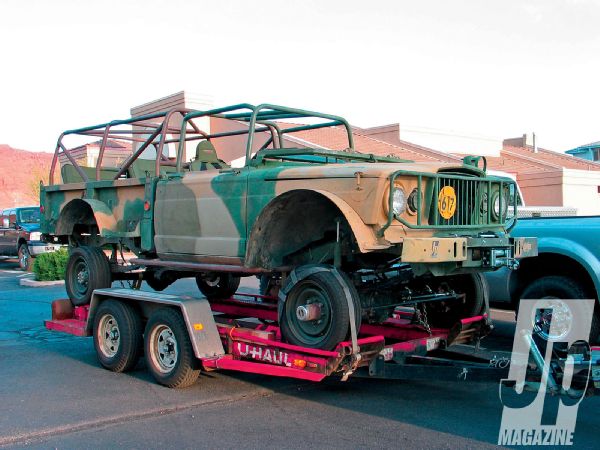
Realistically, these examples border on the extreme ends of the spectrum. Most off-roaders aren't so dull they can't select a tire that works well for their intended use. However, as with anything, you can always delve deeper and perhaps find a better option. Knowledge is power, so up your arsenal with a little tire tech.
General
As little as ten years ago the question wasn't so weighted. Like Coke or Pepsi, you simply chose all-terrain or mud-terrain. There was little wiggle room in between and not many choices within each category. Discounting the really hardcore offerings like those from Interco, your selection usually boiled down to something as simple as a BFG or Goodyear MT or AT. Nowadays it's not so simple, with advanced computer-aided tread design, myriad durometer ratings, different ply weaves, and tread compounds all factored to deliver greater off-road performance as well as a smoother, quieter ride and longer life on the street. And the sheer number of tire manufacturers offering off-road-friendly tires seems never to have been greater. Now, more than ever, the tire shopper needs to come armed to the teeth with information before pulling the trigger on a new set of rolling stock.
Street
While we realize most Jp readers cast their eyes towards off-road performance, there are those who simply want a smooth-running, long-wearing tire for their commuter that will only get used for the occasional off-road foray. For inclement weather performance, look for decent voids and/or circumferential grooves in the tread that will channel standing water out of and away from the lugs. This will reduce the tire's tendency to hydroplane. Also, smaller, more tightly-spaced lugs in the center tread with generous siping (small slits or grooves cut into the tread blocks) will cut down the noise level, increase tread life, and improve traction in the wet, snow and ice. As the tread blocks hit the terrain, the siping opens up, presenting more biting edges for the tread block to grab with. Smaller tread blocks offer more flexibility and less scrubbing as they hit the pavement. Siping can reduce tread block scrub further, allowing more flexibility and improved tread life. This normally translates into improved fuel mileage. The downside to excessive siping is it makes the tire tread more susceptible to chunking and tearing off-road. Finally, side or shoulder treads with solid or tightly-spaced lugs like the Toyo Open Country HT shown, increases tread life and helps prevent uneven tread wear and feathering associated with solid front axle and some IFS light truck applications. Simply put, there's more rubber on the outsides to wear away, so it takes longer.
Snow
When talking snow performance there's shallow, hard-packed, on-road type and then there's deep, sloppy trail breaking type to consider. For starters, if you live in an area that gets a lot of winter weather and are talking about good on-road performance with a mild, hard-packed layer of snow, then many of the characteristics mentioned about ice-friendly tires apply. You want generous siping, good voids for self-clearance, and many biting edges. The tread block size can be extended and the siping reduced without too many ill effects on performance, so this opens up many more contenders with characteristics similar to those offered by the Dick Cepek Mud Country, Mickey Thompson MTZ, Pro Comp Xtreme AT, and the Goodyear Duratrac and Silent Armor.
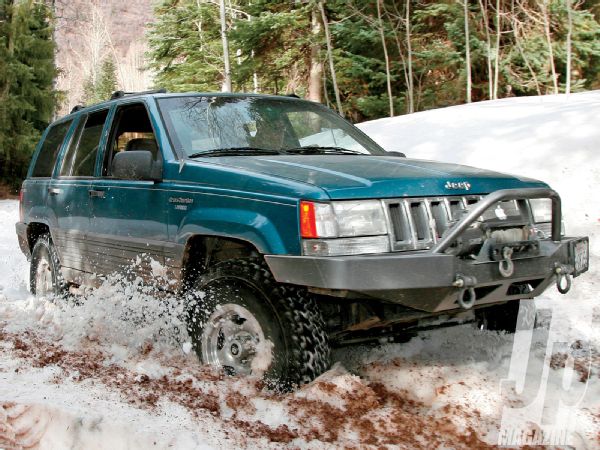
However, if you're talking about deeper snow wheeling on the trail, things get a bit different. You generally want a lot of large, blocky, chunky lugs to grab and claw. Off-road wheeling in the snow will involve a good bit of out-of-control sliding. Eventually you'll wind up in a ditch, pointed in the wrong direction, or finding yourself making numerous high-wheel speed runs to break through the trail. Big lugs with plenty of angularity on the biting edges seem to be the key for success. Some argue that you want a bit of snow to pack between the treads to aid in traction. The theory is the snow packed in the tire treads will adhere to the snow on the ground. We don't know if it's true or not, but one of the worst tires one staffer claims for snow use is a Swamper TSL, while another claims one of the best he used was a Swamper SX. The treads are very similar, so snow type, temperature, and vehicle weight also play a factor. However, the consensus amongst the Jp staff is the old-school Goodyear MT/R tread was probably the best in the snow out of any tire we've used with the BFG Krawler T/A KX a distant second.
Ice
Assuming you're not running a studded snow tire, selecting a tread that's good for ice is probably one of the easier tasks at hand. First and foremost, you want siping and lots of it. Multiple sipes cut into each tread block will allow maximum grip on this most-slippery terrain. Very few drivers are concerned with driving on sheer, clean ice, so keep in mind you want to retain some void space between the tread lugs to aid in the tire's ability to self-clean and to prevent the tread from becoming clogged with snow. For ice, the key is biting edges, biting edges, and more biting edges. A big, blocky lug will just spin and slip. You want lots of smaller lugs with numerous angles to provide not only forward, but lateral and cornering traction as well. Just a few out-of-the-box tires that possess these characteristics include the BFG AT KO, General Grabber AT2, and Pro Comp AT tires.
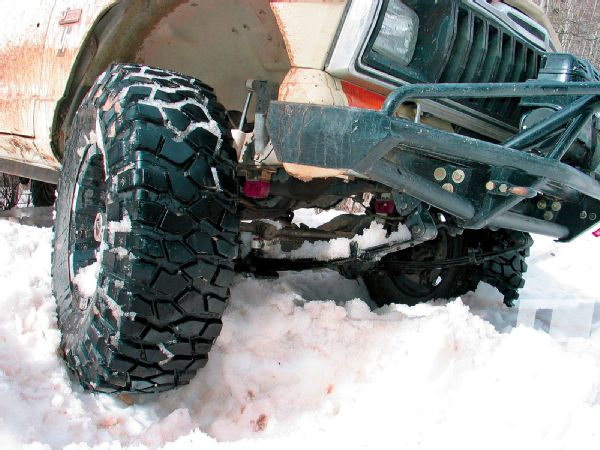
Mud
Mud can be a tricky animal because it can consist of anything from loose and silty to gooey and sticky. Regarding the former, almost any manufacturer's so-called "mud tire" will provide adequate performance. However, we're talking about the worst-case scenario with taffy-like high-clay-content mud that just sticks to everything. You want big, solid, strong lugs with a high-void area between them and tread blocks that ideally extend down the sidewalls to eke out every bit of forward motion. Some tires will run a very short, raised rib between the main lugs to help in self-cleaning because often the centrifugal force from wheel speed may not be enough to get the tires to self-clean. Of all the DOT-legal mud tires out there, the Swamper Bogger by Interco is probably still the standard by which all others are judged. Hardcore mudders will usually cut the smaller tread blocks to open up the tread a bit and make a poor man's paddle tire, but even in stock form, the Bogger is a formidable mud tire. Others in the Swamper family, such as the TSL and its derivatives like the Swamper SX, Swamper Irok, and Swamper LTB are also very effective. Some other gnarly tires we've had luck with in the mud are Pitbull Rocker, Nitto Mud Grappler, and even moderate success with the Mickey Thompson Baja Claw. Like anything, most mudders have their preference, so take the aforementioned mud tires as an example of the extreme end of the tire spectrum which works well in the deep slop. It's been our collective experience that the more street-friendly mud-terrain tires are really better suited as an all-terrain, useful for only light-duty mud use.
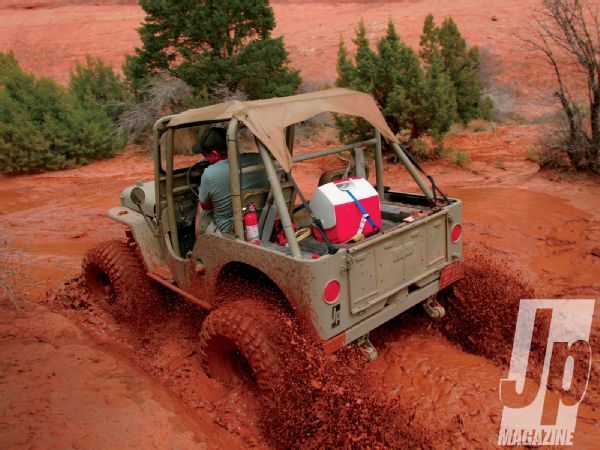
Rock
Believe it or not, tread design isn't the most crucial aspect of a great rock tire's performance. Depending on the type of rocks it can often come down to carcass durability and tire pressure. We've seen mild all-terrain tires at low pressure out-perform purpose-built BFG Krawlers at street pressure, so let's just assume all things are equal and the proper low air pressures are being run. First and foremost you're concerned with sidewall strength and protection. No matter how fancy, a tire is no good if it doesn't hold air. Many manufacturers are now weaving Kevlar plies into radial sidewalls or tightening up the ply weaves for additional strength and puncture resistance. Three- or four-ply sidewalls are what you're after in a radial. Bias-ply tires are generally a bit more gnarly in construction and can withstand an amazing amount of torture. Additionally, lugs that extend down the sidewall not only aid in traction when scaling obstacles with the sides of the tires (which you'll be doing frequently) but offer abrasion resistance and additional protection.
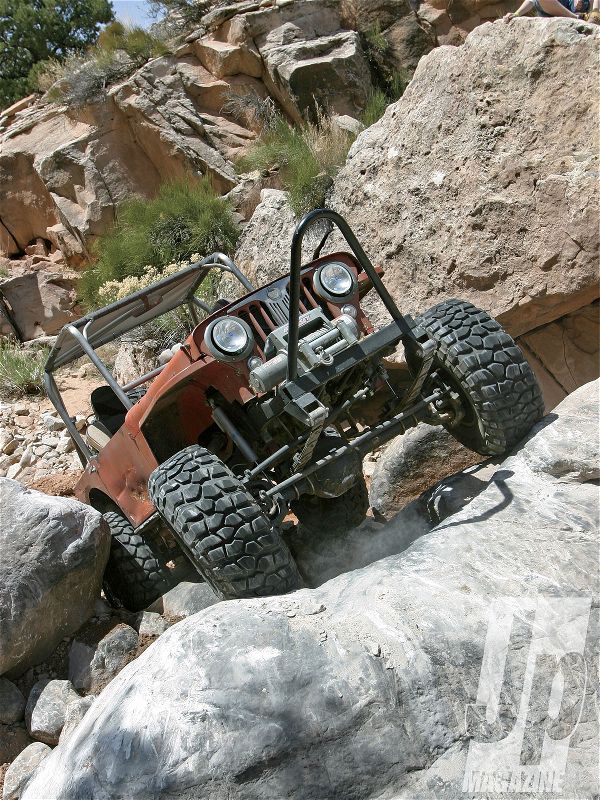
Tread-wise, for the best performance in the widest-range of rock terrain look for moderately sized lugs with a fair bit of spacing in between. You want the spacing to keep some tread block separation and retain a lug's biting edge at lower air pressures. Otherwise, the tread blocks can sort of mush together on the rock surface and not grab hold. Very light siping in the tread blocks can help traction in some situations, but will generally result in chunking and cutting of the lugs if the sipes run too deep. It can also cause the tread to feel squirmy and unstable. For longevity, a solid tread block is ideal.
One of the best rock tires we've run is the BFG Krawler T/A KX. The sidewalls are woven from four plies of seriously tough nylon and the angular tread blocks are stable, yet flexible. To give you an idea of what to look for, some other tread types we've found ideally-suited to the rocks are the old-school Goodyear MT/R, Maxxis Creepy Crawler, Pitbull Rockers, Swamper Irok, TSL, SX, and even the Swamper Bogger. However, while the Bogger can offer crazy forward grip, side stability can suffer because of the directional-nature of the tread blocks. There's not that much sideways gripping tread surfaces. Since rockcrawling can frequently lay you on your side or have you sliding on crazy off-camber angles, you really want a tire with good lateral as well as forward bite, so a blockier, angled tread is better all around.
Sand
If you're going for maximum traction in the sand, there's no avoiding the paddle tire. While a sand paddle's shaped, scooping treads can offer bite that feels to rival that of a drag slick on the pavement, there are numerous downsides. First, they're insanely expensive for a tire that usually has thin, puncture-prone sidewalls and is only good for one terrain. Drive paddles in regular dirt or any short distance on the street and you'll ruin them. Second, you've got to carefully select the number, height, shape, flexibility, and size of the paddles. To work correctly, a paddle tire needs to allow a bit of wheel spin. Too gnarly on the paddles and you'll get no wheel spin. Too light and they'll just spin all the time and eat themselves up. You have to take vehicle weight, gearing, and horsepower into the equation to get it right and that usually means working with the manufacturer and not buying used.
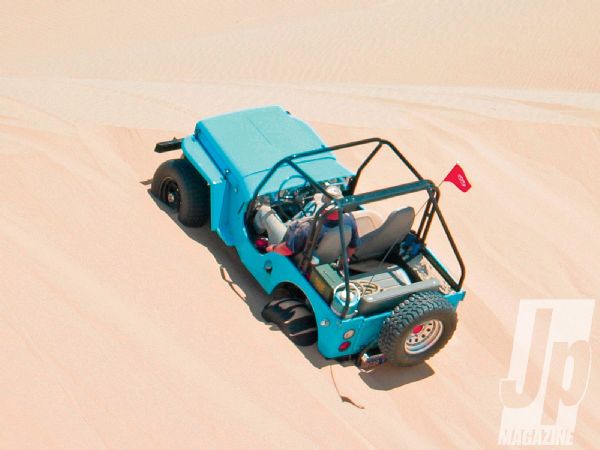
Otherwise, most all-terrain or mud-terrain tires can work well, but flotation is key. You've really got to air down deep into the single digits to increase your contact patch and spread your vehicle weight over a larger area, preventing your tires from just digging in. Some claim a milder all-terrain will work better than a gnarly mud tire because it will float on the top of the sand better. For the most part, this can be true at higher tire pressures, but if you're airing down properly, the more-aggressive mud tires generally will give you better performance in the sand. It should be little surprise that some of our favorite non-paddle sand tires are some of the widest available, including the Pitbull Rocker, Nitto Mud Grappler, Dick Cepek Crusher, and Swamper Irok. The lugs bite and pull while the huge, balloon-like carcass keeps them floating on top and prevents them from digging down.
Recreational Multiuse
This is the land of the computer-geeks. There are so many good computer-designed, mud-terrain tires coming to market nowadays that seem without drawbacks that we simply can't name them all. On the one hand, you've got the more-aggressive recreational tires like the new BFG MT KM2, Goodyear MT/R with Kevlar, Dick Cepek Crusher, and Pro Comp Xterrain that work fine on a daily-driven street rig, but that may serve up some extra street noise and possibly some driving drawbacks. However, lately most new mud-terrains like the Toyo Open Country M/T or Pro Comp Xtreme MT and all-terrains like the Goodyear Duratrac or Falken WildPeak A/T blur the lines distinguishing mud- and all-terrain performance. The new mud-terrains don't suck on the street and the new all-terrains don't suck off-road.
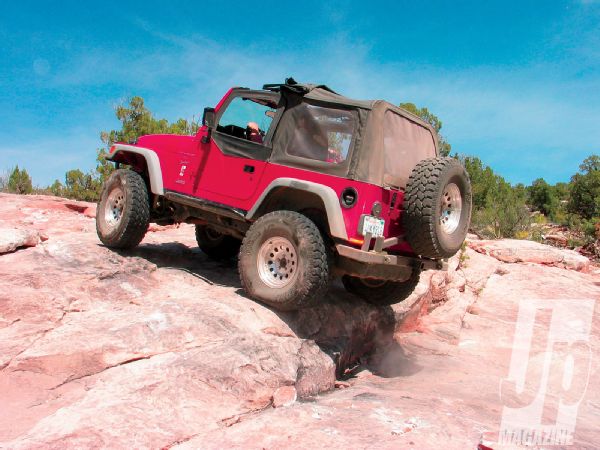
With purpose-shaped tread blocks, generous siping, and heavy shoulder lugs, tires like the Toyo MT and others manage to stay quiet on-road despite some pretty serious off-road prowess. Likewise, the smooth and quiet Duratrac, WildPeak A/T, and other newer all-terrains offer street manners rivaling a passenger car tire without giving up much, if any performance in most off-road conditions. So then, how do we advise our readers which tire attributes are desirable and which aren't? That's a tough one.
We guess it just comes down to your intended terrain, the longevity you expect out of your rubber, and personal preference in terms of looks. Any mud-terrain with blockier tread is going to wear faster than an all-terrain with more rubber in the contact patch, but it'll also have better self-cleaning properties and better grip in the snot-slop. An all-terrain is going to work adequately in many drier off-road climates without nearly as many on-road drawbacks.